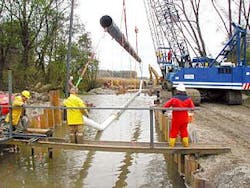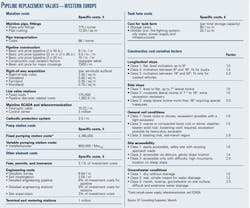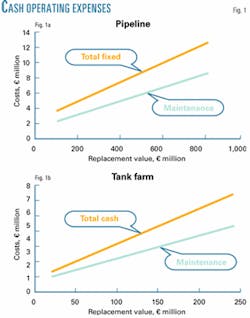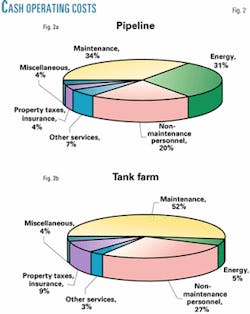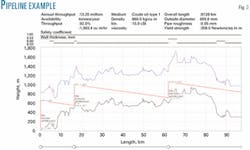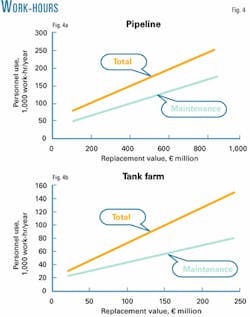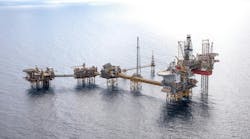A group of seven European oil pipeline companies joined together in late 2000 to initiate a comparative performance analysis of pipeline operations.
The group commissioned Solomon Associates Ltd., Henley on Thames, UK, to perform the benchmarking study. Solomon Associates is known for having developed refinery performance analysis over the last 20 years.
Much historic pipeline benchmarking has concentrated on reliability and integrity issues. This project placed additional emphasis on comparisons of resource consumption (i.e., cash costs), and manpower. This article describes the approach taken and provides sufficient data to permit approximate comparisons of a pipeline company's total cash operating expense and overall personnel utilization with "average" values for the pilot study group.
Although this is a preliminary study within a small group, it shows how mechanisms are being devised that will enable pipeline managers to learn where they can improve operating efficiency.
Subject pipelines
Between them, the seven participating pipeline companies operate six crude oil lines and two clean-products lines. Table 1 illustrates their diversity by showing the ranges of some key attributes.
Because most of the pipeline systems are multibranched networks, capacities denominated only in throughput rates (tonnes per year or barrels per day) would be almost meaningless. Therefore, pipeline capacities have been expressed in terms of both throughput and length (1 tonne-km corresponds to approximately 4.5 bbl-miles).
As Table 1 shows, this group of pipeline systems contains considerable diversity in both capacity and complexity. The range of complexity is illustrated by replacement value divided by capacity. (Replacement values have been calculated in euros and assumed 1 euro = $1.)
Some of the variation in replacement value per unit of capacity is undoubtedly attributable to the differing terrains traversed by the various pipelines. This is illustrated by altitude range: the difference in altitude between the highest and lowest points above sea level for each pipeline system.
Further differences between pipeline systems arise from the ancillary facilities that are associated with each system.
Most participants operated one or more tank farms, but two pipelines were connected to third-party-operated tankage. Similarly, two companies operated marine terminals, one used a third-party-operated facility, while the remainder consisted entirely of inland systems.
These differences led us to conclude that for any worthwhile data analysis, we would have to adopt a modular approach, treating pipelines, tank farms, and jetties as discrete modules. This approach meant that participants would have to allocate operating costs and other data between applicable modules as appropriate. The alternative would have been to collect "pipeline only" data with two major consequent deficiencies:
- The resulting analysis would provide a less than complete picture of each company's operations.
- We could not be sure that participants had satisfactorily accounted for all operating expense data.
Operating expense divisors
A steering group of industry experts drawn from the participating companies helped identify the key issues and parameters. Solomon Associates' analyses of fuels refineries enable comparisons of refineries of varying sizes and complexities on an equitable basis.
That has been achieved through development of "EDC" as an operating expense divisor. EDC originally meant "equivalent distillation capacity" expressed in thousands of barrels per day, but it is now a dimensionless number obtained through regression analysis of operating data.
The steering group postulated that three possible such divisors were installed capacity, utilized capacity (both capacities expressed in tonne-km/year), and replacement value.
As operating complexity and, by implication, cost are affected by the terrain traversed, it seemed that replacement value was likely to represent the most promising divisor. Clearly, if characteristics of terrain are to be taken into account (mountains, hills, farmland, buildings, water crossings, as examples), then replacement values developed from simple cost curves would not be adequate.
ILF Consulting Engineers, Munich, was therefore engaged to provide replacement-value estimates using its own "Pipeline Capital Cost Data Base." This was gained from recent crude oil and oil products pipeline projects in the region, for which ILF has performed engineering, cost engineering, procurement, and construction supervision services.
The accompanying box shows the main component costs used for estimating pipeline-replacement values in Western Europe.
Expense comparisons
When actual operating data were analyzed, the best correlations were obtained on a replacement-value basis. Fig. 1 shows the linear "lines of best fit" for pipelines and tank farms.
For pipelines, Fig. 1a shows total annual fixed cash operating expense (total cash excluding energy) vs. replacement value. Fig. 1b for tank farms depicts total annual cash operating expense.
These relationships allowed evaluation of a "performance gap," positive or negative, denominated in millions of euros, for each pipeline and tank farm, and hence an aggregate performance gap for all of a participant's facilities. Less diversity in the characteristics of tank farms than for pipelines is reflected in a superior correlation coefficient, 0.95 vs. 0.8.
Cash operating expense data were collected for more that 40 categories and subcategories, enabling detailed line-item-expense comparisons.
Valid cost comparisons required several tenets of successful benchmarking:
- Define the envelope. If any participant engages in noncore business activities, the associated operating data must be identified and excluded.
- Define the key issues rigorously and the key parameters unambiguously, so that all data are reported on a consistent basis.
- Collect data in sufficient detail to enable meaningful analysis but avoid data-entry overload. We aim to ask for only those data that are required to manage the business efficiently. For this project, therefore, data collection should have taken no more than 100 man-hr for each participant.
- Validate as much as possible by including internal cross-checks and by determining whether individual data points lie within expected ranges.
- Concentrate on cash expenditures in order to void "interference" from differences in accounting conventions, for example, the treatment of depreciation, capitalization of certain maintenance expenditures.
Fig. 2 shows the distributions of operating expense among major categories for the total groups of pipelines and tank farms.
The striking difference between the charts for pipelines and for tank farms lies in energy contributions. Many pipeline operators expend great effort to minimize energy expenditures, whether through installation of sophisticated pumps and control systems or by the expedient of maximizing pumping operations during off-peak tariff periods.
Often these optimization efforts are thwarted by the demands of shippers, because the costs associated with ship delays and run-outs of crude oil or finished products will always dwarf achievable energy savings.
Of the three major categories of operating expense—maintenance, energy, and personnel—, energy is the most difficult to benchmark and possibly the least susceptible to successful management. Nevertheless energy represents such an important cost component that it would be wrong to ignore the issue in benchmarking.
ILF developed an energy standard for each pipeline, using its own hydraulic software, which has proven to be especially suitable for complex hydraulic systems. The software provided an accurate simulation of the pipeline operation on the basis of average flow rates and such average oil characteristics as density and viscosity.
Fig. 3 shows an example of the hydraulic simulation of a pipeline system.
It should be recognized that the calculated energy standards are based on average throughputs and operating conditions. Also, it is likely that current equipment design techniques would result in different pump configurations from those in place.
Although it may be possible to upgrade pumps, changing their configurations or locations is less likely to be feasible. The calculation of energy standards therefore assumed state-of-the-art pumps but in the existing configuration.
Consequently, the difference between actual consumption and the standard indicates the incentive to invest and the cost of suboptimal operations scheduling. For the eight pipelines, actual energy consumption was found to range between 105% and 140% of the standard. The energy consumption standard ranged between 0.5 and 6 kw-hr/tonne-100 km.
Generally there are three major sources of inefficiencies:
- Pumping configuration: Throttling of pregenerated pressure could be avoided by more flexible use of pumps (shut on/off or use of variable speed control, for example).
- Pumps and motor-drive efficiencies. The efficiency factors of pumps and motor drives can have an important effect, especially on older pipeline systems. In several cases an exchange or revamp of pumps and motor drives may be justified.
Generally, a deviation of 1% efficiency is equivalent to 1% energy consumption. Efficiency factors of 85% for pumps and 97% for motor drives represent the current standards that were used for performance analysis.
- Pipeline mechanical availability: More consistent utilization of the pipeline can be achieved through high availability (typically between 93% and 95%). In order to attain high levels of mechanical availability, good maintenance (preventive or risk based) is essential.
Due to supply-related and operational reasons, including periodically necessary shutdowns for maintenance or repair, it is not always possible to maintain a constant flow. Recovery of down time through a higher flow rate inevitably impairs energy efficiency, as the following example illustrates:
The average flow rate of a pipeline is 3,200 cu m/hr and a shutdown for 36 hr is required. If, to recover that downtime, flow rate is increased to 4,400 cu m/hr, there is 5.17% increase in overall energy consumption. If the flow rate increase is to 6,000 cu m/hr, the overall energy consumption increase would be as high as 7.85 %.
Personnel use
In comparisons of use of personnel resources, it is insufficient to analyze costs because these reflect pay rates that can vary considerably from location to location. Therefore, manpower resource utilizations were compared in terms of both cash expenditure (employee salaries, wages, and benefits along with the cost of all contract personnel) and total work hours consumed in operating and maintaining the facilities.
Such data were collected for more than 30 line-item categories of personnel activities. Fig. 4 shows relationships between work-hours, for both maintenance and total personnel, and replacement value.
Closer linear correlations were obtained for work-hours than for operating expense: coefficients of 0.85 for pipelines and 0.95 for tank farms, when plotted against replacement value. An important feature of our approach to personnel utilization is that we ask for all hours worked by both employees and contract personnel. As the proportion of outsourcing varies from operator to operator, it is impossible to make valid personnel comparisons unless we account for all work-hours. Further, we take the view that third-party contracts cannot be properly evaluated and monitored without some knowledge of the labor content.
More studies
This brief review has concentrated on current expenditures, but we analyzed data in other areas as well: patterns of historic and forecast investment, maintenance practice, reliability (downtime and its causes), and safety (spills and accidents).
Solomon found from its refinery studies that relationships between maintenance practice and reliability are often only discernible over successive studies. Commitment by the original participants to a second study early next year should ensure progress in this area. Additionally, the launching of a North and South American study in 2003 will provide many more data points, further enabling analysis of data and practice relationships.
Although this pilot study was conducted among a small number of pipeline systems of diverse complexity, the results are encouraging. We are not yet satisfied, however, that we have found a representation of pipeline capacity and complexity that parallels the value of EDC as a divisor in Solomon Associates' fuels refinery analyses.
For the second of these studies, we have modified the input data requirements so that, for example, we can distinguish between maintenance expenditure on pipe and more complex pump station equipment. A number of such changes together with more data from increased participation should enable that divisor to be developed and refined.
The authors
Roger Holden ([email protected]) has been a consultant with Solomon Associates Ltd. for the last 8 years; he has 35 years' downstream oil industry experience in Europe and the US. Holden holds a BSc (1967) in chemical engineering from the University of Nottingham, UK.
Ernesto Soria ([email protected]) is an oil and gas consultant at ILF Consulting Engineers, Munich. He studied at the University of Saragossa in Spain, where he participated in a year-long exchange program with the University of Glasgow in Scotland during 1994-95, then received a MSc (1998) in industrial engineering. In 2000, Soria also received an MBA from the European University in Munich.


